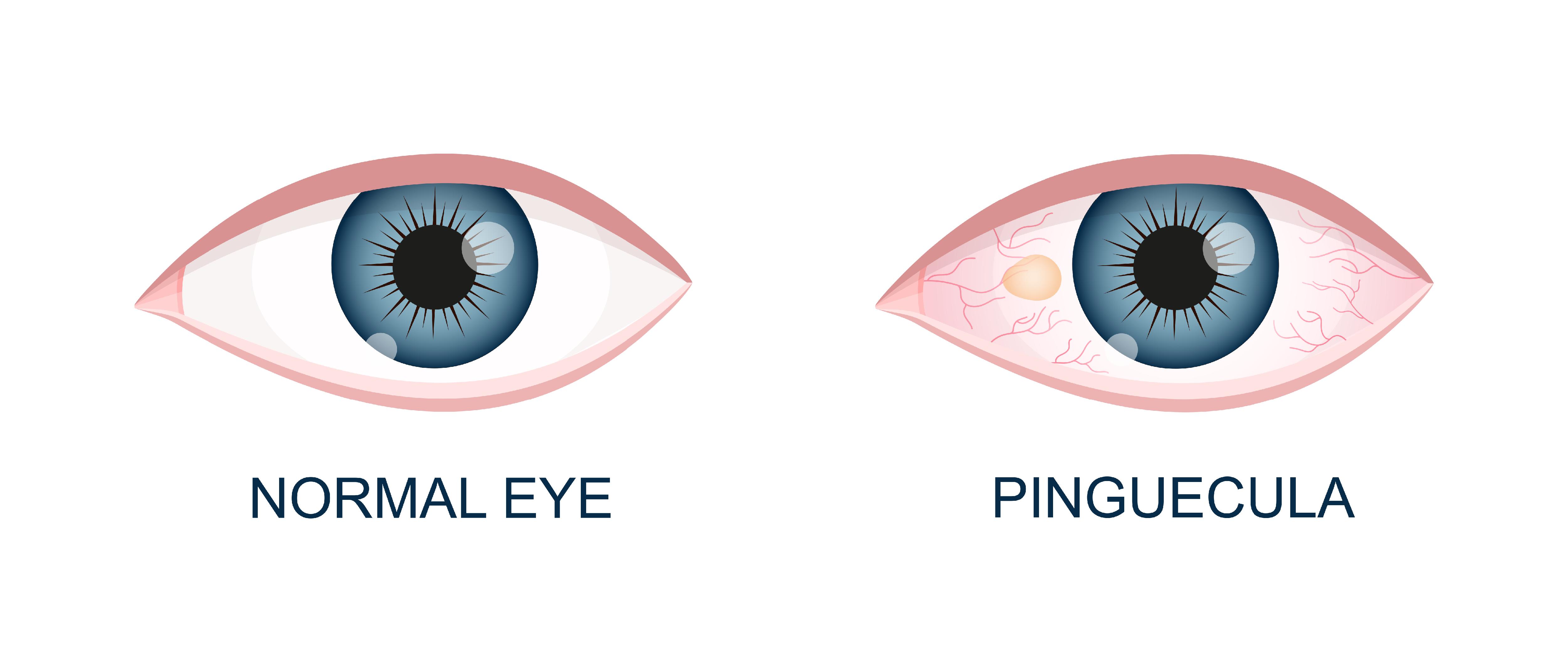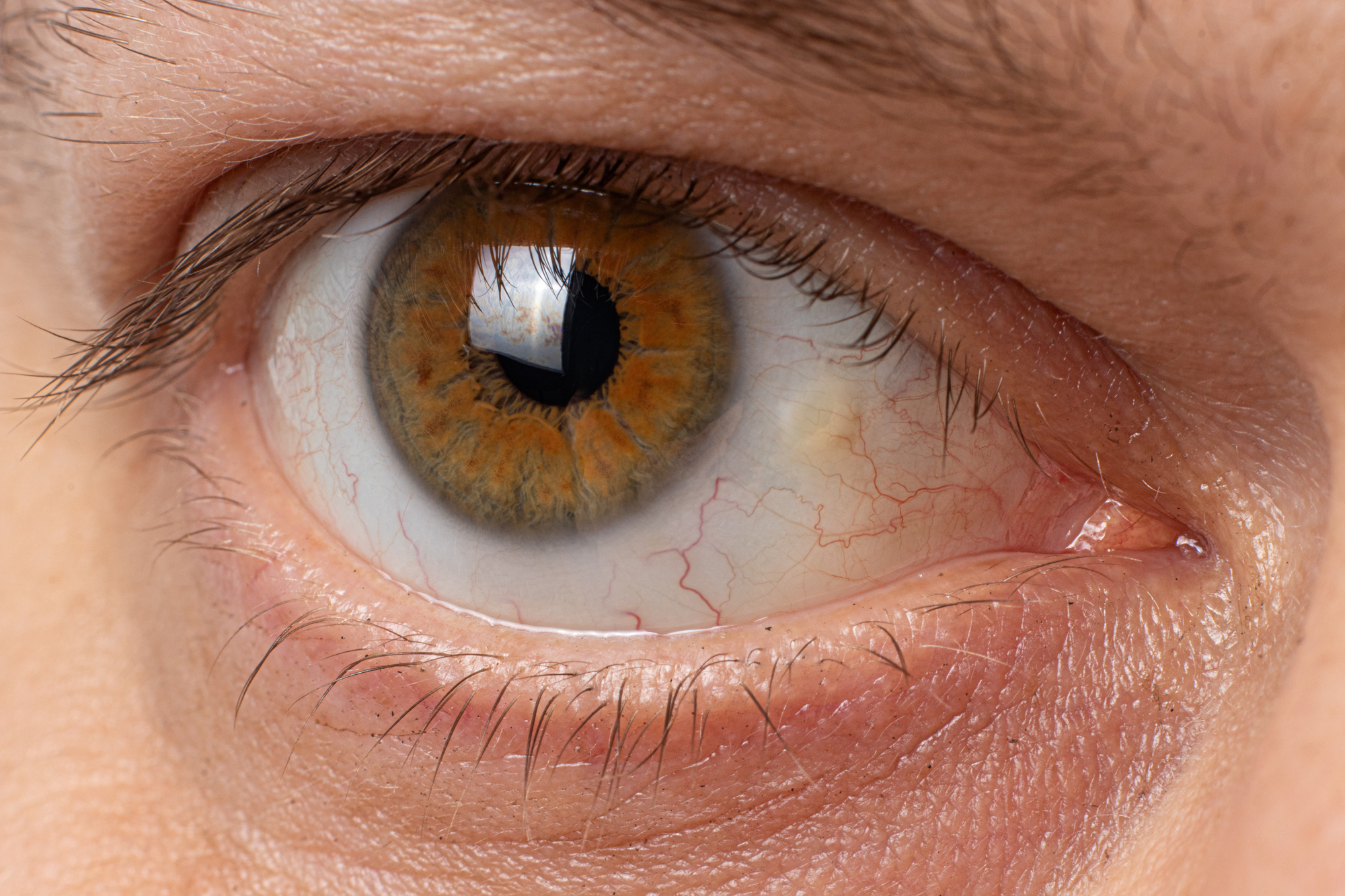Updated on May 20, 2025
Pinguecula


Vision Center is funded by our readers. We may earn commissions if you purchase something via one of our links.
Noticing a yellowish spot in your eye can be alarming, especially if you start feeling other symptoms. Fortunately, most of the time it’s a harmless yellow bump, known as a pinguecula.
However, it’s important to know the difference between a pinguecula and other possible conditions. In this article, we’ll talk about what a pinguecula is, why it develops, and how it can be managed.
What Is a Pinguecula?
A pinguecula is a yellowish raised, noncancerous growth on the conjunctiva — the clear membrane covering the white part of your eye (sclera).

Pingueculae are often found on the conjunctiva near the inner corner of the eye (closer to the nose) and rarely grow onto the cornea (the clear front part of the eye).
While these bumps are noticeable, they don’t typically affect vision. However, a pinguecula can affect your vision if it becomes irritated or inflamed.
What Causes Pinguecula?
Pinguecula is primarily caused by chronic irritation from environmental exposure, which includes:
- Chronic UV exposure. Frequent and prolonged exposure to sunlight, particularly its UV radiation, is considered the primary cause.
- Wind and dusty environments: Constant exposure to wind, dust, sand, or air pollutants irritates the conjunctiva, promoting the growth.
- Dry conditions: Living in arid climates or working in environments with low humidity can increase irritation and dryness, encouraging pinguecula formation.
- Contact-lens irritation: Poorly fitting contacts or prolonged contact lens use may cause chronic eye irritation, potentially triggering or worsening a pinguecula.
Additionally, jobs like farming, fishing, and construction can increase your likelihood of developing a pinguecula.

The main reason this happens is that these environmental irritants can alter the conjunctival tissue, leading to the deposition of abnormal fat, protein, or calcium.
How To Distinguish Pinguecula From Other Conditions
Because of its appearance, a pinguecula can look similar to other, more serious eye conditions. Here’s how you can tell the difference:
- Pterygium. Unlike a pinguecula, a pterygium is a fleshy, wedge-shaped growth that can invade the cornea, potentially causing blurred vision or astigmatism.
- Jaundice. Pingueculae are often mistaken for jaundice, a systemic condition causing generalized yellowing of the eyes and skin due to liver issues. Pingueculae, however, are localized spots and unrelated to liver function.
- Cancerous growth. Cancerous growths on the eye can appear as dome-shaped or shiny red or pink patches. They can also appear as sores that heal and return. Meanwhile, pingueculae are typically yellowish, raised spots.
If you see a raised yellow spot, rest assured, it's most likely harmless, but it's always best to confirm with an eye care professional.
What are the Symptoms of Pinguecula?
A person may develop more than one pinguecula, and they can occur in one or both eyes. The symptoms can be mild or severe and may include:
- Irritation and eye inflammation (pingueculitis)
- Eye redness
- Blurred vision (if the pinguecula is large or causes significant tear film disruption)
- Itching
- Teary eyes
- Burning sensation
- Dry eyes
- Eye discomfort
- A sensation of having something in your eye, like sand or grit (foreign body sensation)
When Should You Call a Doctor?
In most cases, a pinguecula poses little threat to vision. However, if it grows larger, becomes frequently inflamed, or appears to spread towards the cornea, it may be evolving into a pterygium.
Pterygia are invasive growths that can blur vision or induce astigmatism. If you notice any of the following, consult an eye care professional immediately:
- Noticeable enlargement or thickening of the pinguecula
- Significant or persistent redness or ongoing discomfort
- Blurred or distorted vision developing around the growth
Regular check-ups help ensure any complications are managed before they impact your vision.
How Is Pinguecula Treated?
Pinguecula doesn’t always require treatment. Mild symptoms can often be managed using artificial tears. For more significant inflammation, steroid eye drops or ointments are prescribed by a doctor for a short period.
The eye drops help lubricate the eye and reduce irritation that could worsen the condition. However, surgery may be recommended in severe cases or for persistent symptoms.
More specifically, your ophthalmologist may recommend surgery for pinguecula in the following instances:
- The growth is large enough and causes blurry vision or significantly alters the tear film.
- You want the pinguecula extracted for cosmetic reasons.
- The affected eye(s) remain sore and inflamed despite treatment with eye drops.
- If wearing contact lenses becomes uncomfortable or impossible.
What To Expect from Surgery?
Removing pingueculae is typically an outpatient procedure. This means you’ll go home on the same day.
The procedure involves removing the pinguecula and repairing the area, often with a graft of healthy conjunctiva or other suitable eye tissue to promote healing and reduce recurrence. After the surgery, you’ll need to wear an eye patch for a few days to protect the eye as it heals.
Keep in mind that a pinguecula can sometimes grow back even after surgery, though this isn't common. Currently, there aren’t any medications proven to reliably prevent pinguecula recurrence.
Some medications are occasionally used after surgery for a different type of growth called a pterygium, but they're not standard treatment for pinguecula removal:
- Antimetabolites (such as mitomycin C or 5-fluorouracil). These drugs may reduce the risk of recurrence after pterygium surgery, but they come with risks, including rare yet serious complications like scleral or corneal melting.
- Anti-VEGF injections (such as bevacizumab). These injections are sometimes used beneath a pterygium to help prevent regrowth or improve surgical outcomes, but they haven't been shown to be effective for pinguecula.
Your eye doctor will determine if any additional treatment is appropriate based on your specific case.
How Long Does Pinguecula Last?
A pinguecula is a permanent alteration of the conjunctival tissue and will not resolve on its own.
While many pingueculae remain stable and cause minimal symptoms that can be managed with conservative treatments, the physical growth itself persists unless surgically removed.
If surgery is performed, recovery from the procedure can take several weeks, potentially a month or longer, for the eye to fully heal and discomfort to subside.
How to Prevent Pinguecula
Here are some ways to avoid the emergence, recurrence, or worsening of pinguecula:
- Wear UV-blocking glasses and sunglasses outdoors to shield your eyes from direct sunlight.
- Wear a wide-brimmed hat to protect your eyes from direct sunlight further.
- Wear protective eyewear (like wrap-around glasses or goggles) in windy or dusty conditions to shield your eyes from the wind, dust, and other outdoor elements.
- Use artificial tears (lubricating eye drops) to moisten your eyes and reduce dryness and discomfort, especially in dry or windy environments.
In this article
7 sources cited
Updated on May 20, 2025
Updated on May 20, 2025
About Our Contributors
Lauren, with a bachelor's degree in biopsychology from The College of New Jersey and public health coursework from Princeton University, is an experienced medical writer passionate about eye health. Her writing is characterized by clarity and engagement, aiming to make complex medical topics accessible to all. When not writing, Lauren dedicates her time to running a small farm with her husband and their four dogs.
Dr. Melody Huang is an optometrist and freelance health writer with a passion for educating people about eye health. With her unique blend of clinical expertise and writing skills, Dr. Huang seeks to guide individuals towards healthier and happier lives. Her interests extend to Eastern medicine and integrative healthcare approaches. Outside of work, she enjoys exploring new skincare products, experimenting with food recipes, and spending time with her adopted cats.

